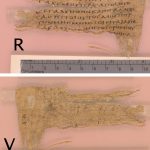| Artefact ID | 1646 |
| TM ID | TM 31771 |
| Findspot (DEChriM ID) | 28 (al-Bahnasā) | Class | Textual |
| Material | Papyrus |
| Writing medium | Sheet/roll |
| Text content | Documentary |
| Language | Greek |
| Description | P.Oxy. XII 1592, P.Oxy. 12 1592: Letter from a woman to her “father” |
| Selection criteria | Christian terms/formulas/concepts |
| Date from | 300 |
| Date to | 399 |
| Dating criteria | Palaeography. The ed.pr. considered this letter (alongside P.Oxy. XII 1492, 1493, and 1494) to be among the oldest Christian documents from Egypt. |
| Absolute/relative date | Relative date |
| Archaeological context | Found in al-Bahnasā (Oxyrhynchos) during the excavations of Bernard Grenfell and Arthur S. Hunt between 1896 and 1907. |
| Accession number | Sydney, Macquarie University 615 |


 Json data
Json data




